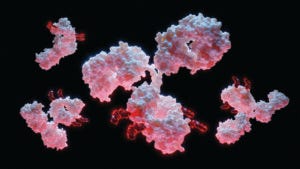- Sponsored Content
Developers Work To Refine Platforms for the Best Results
September 19, 2023

On the cover: an artist’s rendering of antibody molecules with linker–toxin payloads attached. HTTPS://STOCK.ADOBE.COM
Antibody-conjugate technologies have been pushed out of the limelight somewhat in recent years by mRNA/oligonucleotides and cell/gene therapies. Yet while many people were talking about the “next big thing” — and remember, the next big thing in cancer treatment not so long ago was antibody–drug conjugate (ADC) therapy — this now-maturing segment of the biopharmaceutical industry has begun proving its worth. As of November 2022, the US Food and Drug Administration (FDA) had approved 14 different ADCs for cancer indications. Seagen has led the way in commercializing four products, two on its own and two in partnership with other companies. Genentech (Roche) has commercialized two. Pfizer has two through its acquisition of Wyeth, and AstraZeneca has one of its own and one in partnership with Daiichi Sankyo. Companies with one marketed product include ImmunoGen, ADC Therapeutics, Immunomedics, and GSK. Eight of those 14 products have been approved since 2019, and 249 ADC clinical trials were initiated in 2022 (up ~33% from 2021).
A diversity of conjugation technologies has arisen from the complexity of this drug modality. Each component (antibody, conjugation chemistry, and linker/payload) can be a complex molecule in itself, with many aspects that influence the efficacy and safety profile of the combined product. Developers need to optimize those components to work together and achieve desired results. But efforts are underway around the world to understand better how to accomplish that optimization as a part of an integrated drug-design philosophy. Published insights such as those described herein can help developers improve their own conjugate products and processes. A detailed review from authors at the FDA Center for Drug Evaluation and Research (CDER) is a good place to begin, highlighting the status of ADCs marketed and in development for cancer as of 2021, with discussion of translational strategies to improve product quality, safety, and efficacy (1).
Below I provide a snapshot from the mAbs journal of some activities in product development, linker chemistry, and analysis of antibody conjugates since then. My emphasis is on ADCs, to which most development work is directed. But many more conjugation applications are in the works.
Conjugation Chemistry
Modern approaches to conjugating drugs and other molecules to antibodies are trending away from random toward site-specific integration of linker molecules. That makes sense, after all, because monoclonal antibodies (MAbs) are all about specificity. Now the parallel goals in development of an ADC are
• site-specific incorporation of a drug payload that won’t interfere with antigen binding
• an optimal drug/antibody ratio for sufficient potency without triggering aggregation or insolubility
• a homogeneous final product that can get approval from regulatory agencies.
In early ADCs, including some that are already on the market, the drug molecules are chemically attached randomly to antibody-surface amino acids, typically lysine or cysteine. Such random structures lead to overall product heterogeneity, long-term instability in solution, and unsatisfactory pharmacokinetics. In some cases, the tacked-on toxins get in the way of epitope binding and targeting.
The clinical benefit of many ADCs is limited by off-target toxicity and narrow therapeutic windows — as detailed by Peter Alexander, et al. elsewhere in this featured report. To overcome those limitations, ABL Bio Inc., Samsung Biologics, and Reyon Pharmaceutical Company in South Korea are working together on conjugating cytotoxins to N-terminal sites on antibodies with amine bonds caused by reductive alkylation (2). They reported in 2021 on results of testing stability, efficacy, and toxicity of “NTERM”-conjugated ADCs both in vitro and in vivo compared with thiol- and lysine-conjugated ADCs. The new method produced less-toxic drugs with comparable to better efficacy. “These results suggest that the NTERM conjugation method could widen the therapeutic window of ADCs by enhancing [their] stability and reducing toxicity.”
In 2022, authors from Synaffix BV in the Netherlands (now part of the Lonza Group) reported on technology that uses the N-glycosylation site on MAbs to generate stable and site-specific ADCs based on enzymatic remodeling and metal-free click chemistry (3). The team engineered endoglycosidase and a native glycosyl transferase for simple, efficient glycan remodeling that incorporates a sugar substrate in a system that is optimized by inclusion of anionic surfactants. Compared with a currently marketed ADC, the therapeutic potential of GlycoConnect–HydraSpace technology showed significantly improved efficacy and tolerability.
And in 2023, authors from the National Research Council of Canada described a controlled process for generating ADCs using functionalized sialic acids to conjugate drug molecules only to N-linked glycans on the MAbs’ antigen-binding fragments (Fabs), with a narrow drug/antibody ratio range (4). Using a bacterial sialytransferase, the team incorporated N-azidoacetylneuraminic acid (Neu5NAz) into the Fab glycan on cetuximab. But only ~20% of human IgG1 molecules have a Fab glycan, so developers can use molecular modeling to introduce N-glycosylation sites to the Fab constant region of other therapeutic MAbs. The authors used that strategy to click Neu5NAz with monomethyl auristatin E (MMAE) attached to a self-immolative linker terminated with dibenzocyclooctyne (DBCO) onto trastuzumab molecules. The resulting cetuximab-MMAE and trastuzumab-MMAE ADCs have drug/antibody ratios in the sweet-spot range of 1.3–2.5. They bind their targets efficiently and are as potent in cytotoxicity assays as control ADCs made with standard protocols. “The site-directed conjugation to Fab glycans has the additional benefit of avoiding potential interference with effector functions that depend on Fc glycan structure,” the authors conclude (5).
ADC Analytics
As with their protein constituents, the complexity of conjugate products creates a need for powerful analytical methods that can help developers characterize their products and the processes used to make them. Advancements in analytics led to the well-characterized biologics revolution of 25 years ago, and such technologies have continued to expand and improve since then. Now powerful computers and software are taking analytical capabilities beyond what once may have been thought possible. It may well be that such advanced modalities as ADCs and cell/gene therapies could not have come about without such technological progress happening in parallel.
With all the benefits that site-specific conjugation provides, it does come with its own challenges. Mammalian-cell expression of cysteine-engineered antibodies for eventual conjugation, for example, can entail developability complications including production of fragments and heterogeneous molecules. With associated critical quality attributes (CQAs) of the drug substance in mind, developers often use liquid chromatography with mass spectrometry (LC-MS) to characterize and monitor for the presence of such product-related impurities. However, as authors from Merck and Michigan State University point out in a 2023 mAbs publication (6), that technique is limited by coelution and signal suppression of antibody fragments alongside the correct molecules. It is also difficult to use for separating antibody–oligonucleotide conjugates (AOCs) with different numbers of conjugated oligos.
The authors used capillary zone electrophoresis (CZE) with MS as an alternative method. Analysis of six ADCs made with different MAbs and drug–linker payloads revealed that impurities such as half MAbs and light chains with one or two drugs attached, clipped heavy chains, and light chains with truncated C-terminal cysteines could be resolved from the correct molecules using this method. An optimized protocol enabled characterization of two AOCs. The team showed that CZE-MS could separate the MAbs with and without linkers based on altered size/charge. “Our study showcases the good performance and broad applicability of CZE-MS techniques for monitoring the heterogeneity of cysteine-engineered ADCs and AOCs,” the authors concluded (6).
In a 2021 study, authors from Bristol Myers Squibb reported on characterization of a lysine-conjugated ADC using tryptic peptide mapping and LC with high-resolution MS (7). In this case, unexpected cysteine linkages were detected and attributed to interchain disulfide bonds that developed during the conjugation reaction. As predicted by solvent-accessibility modeling analysis, nonreactive (unconjugated) lysine residues and intact intrachain disulfide bonds were noted. “We also discovered a major by-product derived from the hydrolysis of the amidine moiety of the N-terminus conjugate,” the authors reported. “In contrast, the amidine moiety in lysine-linked conjugates appeared stable. Based on our results, we propose plausible formation mechanisms of cysteine-linked conjugates and the hydrolysis of the N-terminus conjugate, which provide scientific insights that are beneficial to process development and drug quality control.”
Authors at Genentech (Roche) collaborated with a team at the FDA CDER in 2022 on stability research of MAb therapeutics, including ADCs, which get exposed to metal ions during manufacturing and storage (7). These drug substances are vulnerable to metal-catalyzed oxidation, which can change their structure and function, with consequences on efficacy, potency, and potentially, immunogenicity. The researchers stressed MAbs and ADCs with copper- and iron-based metal-oxidizing systems and evaluated the results on size distribution, carbonylation, Fc effector functions, antibody-dependent cellular cytotoxicity (ADCC), cell antiproliferation, and autophagic flux. Effects were found to be molecular-site specific and led to reduced bioactivity in both MAbs and conjugates, but not to a great extent.
“Our study clearly demonstrates that transition-metal ion binding to therapeutic IgG1 MAbs and ADCs is not random,” the authors concluded (7), “and that oxidation products show unique structural and functional ramifications. A critical outcome from this study is our highlighting of key process parameters [and] route of degradation, especially oxidation (metal catalyzed or via [reactive oxygen species] ROS), on the CH1 and Fc region of full-length MAbs and ADCs.”
Their colleagues at Genentech (Roche) had highlighted in vivo stability in a 2020 publication (8). ADCs need to be stable in circulation to reach their target cells intact. The authors highlighted vulnerabilities related to linkers, payloads, and the sites of drug attachment. The team sought to prevent unstable conjugates to support the design and optimization of high-volume products before they began testing in animal models. So they established an in vitro screening method that could correlate with in vivo stability.
The biopharmaceutical industry often uses blood plasma in assessments of in vitro stability. But this team found disconnects between those results and actual in vivo outcomes for the product tested. A whole-blood assay worked better, with a coefficient of determination of R2 = 0.87 rather than 0.34 for a protocol using plasma that hasn’t been frozen. Using the mouse whole-blood assay predicted in vivo stability in rats, cynomolgus monkeys, and humans. The method also uses a shorter incubation time (one day) and custom analysis software for increased throughput and in-depth characterization of biotransformation. The authors concluded that although some instabilities remained more difficult to identify, the whole-blood method “greatly enhanced the process of screening, optimizing, and lead candidate selection, resulting in the substantial reduction of animal studies” (8).
Product Performance
Pharmacodynamics and pharmacokinetics are crucial parameters for all drugs — but for ADCs in particular because of the danger their payloads can present to healthy cells. Chemotherapy survivors like me are well aware of that danger, which manifests in relatively temporary ways such as hair loss and digestive-system disruption and causes long-term damage such as sterility and loss of organ function. Using MAb targeting to prevent such problems, ADCs are meant to deliver cytotoxins that kill only cancer cells while leaving the rest of a patient’s body relatively untouched. But biology is never that straightforward, so it’s important to study what actually happens to these molecules in patients’ bodies.
In 2021, a Pfizer team reported on a targeting and biodistribution study of an ADC in a melanoma xenograft model using fluorescence molecular tomography (FMT) and positron-emission tomography (PET) imaging methods (9). Both showed antigen-specific accumulation of the antibody and an auristatin-conjugated form in targeted tumors. And the ADC showed dose-dependent antitumor effects on xenograft mice, with 90% complete responders at 3 mg/kg. The team was pleased with the potential this study demonstrated for the ADC in development as an anticancer agent.
Antibodies bring not only targeting power to ADCs, but also an extended half-life in circulation. In a 2023 report from Janssen, the authors describe a site-specific conjugation of a dual agonist peptide (an oxyntomodulin variant engineered for potency and in vivo stability) to the complementarity-determining regions (CDRs) of an immunologically silent immunoglobulin G class 4 (IgG4) antibody (10). Janssen identified and used a cysteine-containing heavy chain CDR3 variant that provided clean bivalent conjugation to a bromoacetylated peptide without interference from endogenous cysteine residues. The resulting MAb–peptide homodimer showed high potency for two target receptors with a single dose in both mice and cynomolgus monkeys. The authors noted increased results with their bivalent conjugate over those from a monomeric analog, “clearly demonstrating translation of the measured in vitro avidity to in vivo pharmacology.”
In another 2023 publication, collaborators from Codeable Therapeutics (Palo Alto, CA), Applied BioMath (Concord, MA), and Takeda Pharmaceutical Company (Cambridge, MA) suggested a revised understanding of ADC potency compared with that of the corresponding chemotherapies alone (11). Citing a recent review article in Cancer Cell, the authors acknowledged the similar maximum tolerated doses (MTDs) observed in clinical testing of both modalities, which has led some to question the assumption that ADCs could increase the MTD of cytotoxic molecules. But this team pointed out that a drug’s therapeutic index (TI) must also account for its minimal effective dose (MED). “When using an exposure-based TI calculation method, the superior antitumor activities of ADCs relative to their corresponding chemotherapy can readily be explained.” Highlighting both clinical and preclinical data supporting lowered MEDs for ADCs, the authors illustrated TI improvements of ADCs over chemotherapies. “We believe that our revised model can provide a blueprint for future improvements in protein engineering and chemical engineering of toxins to further advance ADC research and development,” they concluded (11).
Manufacturing Matters
All those considerations and more affect decisions made in manufacturing process development for ADCs and other conjugate products. See the next article in this featured report for a more detailed discussion of how.
References
1 Dean AQ, et al. Targeting Cancer with Antibody–Drug Conjugates: Promises and Challenges. mAbs 13(1) 2021: 1951427; https://doi.org/10.1080/19420862.2021.1951427.
2 Ko MJ, et al. N-Terminal Selective Conjugation Method Widens the Therapeutic Window of Antibody–Drug Conjugates By Improving Tolerability and Stability. mAbs 13(1) 2021: 1914885; https://doi.org/10.1080/19420862.2021.1914885.
3 Wijdeven MA, et al. Enzymatic Glycan Remodeling–Metal Free Click (GlycoConnect™) Provides Homogenous Antibody–Drug Conjugates with Improved Stability and Therapeutic Index Without Sequence Engineering. mAbs 14(1) 2022: 2078466; https://doi.org/10.1080/19420862.2022.2078466.
4 Jaramillo ML, et al. A Glyco-Engineering Approach for Site-Specific Conjugation to Fab Glycans. mAbs 15(1) 2023: 2149057; https://doi.org/10.1080/19420862.2022.2149057.
5 Xu T, et al. Interrogating Heterogeneity of Cysteine-Engineered Antibody–Drug Conjugates and Antibody-Oligonucleotide Conjugates By Capillary Zone Electrophoresis–Mass Spectrometry. mAbs 15(1) 2023: 2229102; https://doi.org/10.1080/19420862.2023.2229102.
6 Qiu D, et al. Characterizing and Understanding the Formation of Cysteine Conjugates and Other By-Products in a Random, Lysine-Linked Antibody Drug Conjugate. mAbs 13(1) 2021: 1974150; https://doi.org/10.1080/19420862.2021.1974150.
7 Glover ZK, et al. Physicochemical and Biological Impact of Metal-Catalyzed Oxidation of IgG1 Monoclonal Antibodies and Antibody–Drug Conjugates Via Reactive Oxygen Species. mAbs 14(1) 2022: 2122957; https://doi.org/10.1080/19420862.2022.2122957.
8 Fourie-O’Donohue A, et al. Improved Translation of Stability for Conjugated Antibodies Using an In Vitro Whole Blood Assay. mAbs 12(1) 2020: 1715705; https://doi.org/10.1080/19420862.2020.1715705.
9 Gupta P, et al. Targeting and Pharmacology of an Anti-IL13Rα2 Antibody and Antibody–Drug Conjugate in a Melanoma Xenograft Model. mAbs 13(1) 2021: 1958662; https://doi.org/10.1080/19420862.2021.1958662.
10 Camacho RC, et al. Conjugation of a Peptide to an Antibody Engineered with Free Cysteines Dramatically Improves Half-Life and Activity. mAbs 12(1) 2020: 1794687; https://doi.org/10.1080/19420862.2020.1794687.
11 Gerber HP, Gangwar S, Betts A. Therapeutic Index Improvement of Antibody–Drug Conjugates. mAbs 15(1) 2023: 2230618; https://doi.org/10.1080/19420862.2023.2230618.
Cheryl Scott is cofounder and senior technical editor of BioProcess International (part of Informa Connect Life Sciences); 1-212-600-3429; [email protected].
You May Also Like






